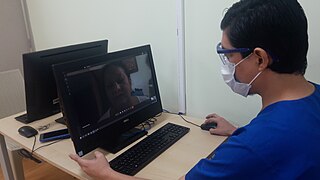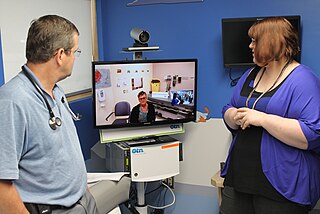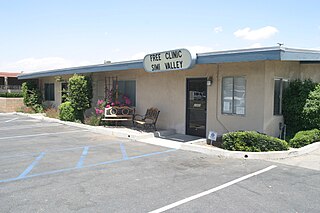Medical desert is a term used to describe regions whose population has inadequate access to healthcare. [1] The term can be applied whether the lack of healthcare is general or in a specific field, such as dental or pharmaceutical. [2] It is primarily used to describe rural areas although it is sometimes applied to urban areas as well. [2] The term is inspired by the analogous concept of a food desert. [1]
An estimated 30 million Americans, many in rural regions of the country, live at least 60 minutes drive from a hospital with trauma care services. [3] Limited access to emergency room services, as well as medical specialists, leads to increases in mortality rates and long-term health problems, such as heart disease and diabetes. [4] [5] Medicare, Medicaid, and uninsured patients are less likely than others to live within an hour's drive of a hospital emergency room. [3]
Since 1975, over 1,000 hospitals, many in rural regions, have closed their doors because they are unable to bear the cost of care of uninsured patients. [6] That has required some patients in every state to drive at least an hour to a hospital emergency room. The problem poses an even greater danger during the COVID-19 pandemic, when patients in respiratory distress urgently need oxygen [7] and can ill afford an hour-long ambulance ride to reach a hospital. In addition to the immediate financial problems facing rural healthcare providers, inequities in rural healthcare are further aggravated by the disproportionately low number of newly-graduated doctors applying for positions in rural areas.
Although concentrated in rural regions, health care deserts also exist in urban and suburban areas, particularly in Black-majority census tracts in Chicago, Los Angeles, and New York City. [8] Medical literature addressing health disparities in urban centers has applied the term medical desert to areas that are more than five miles from the nearest acute care facility. [8] Racial demographic disparities in healthcare access are also present in rural areas, particularly with Native Americans living in rural areas receiving inadequate medical care. [9] [10]
Pharmacy deserts have developed in some urban areas, [11] [12] a situation that has increased the challenge of distributing and administering vaccines for the COVID-19 pandemic. [13] [14] [15]

An emergency department (ED), also known as an accident and emergency department (A&E), emergency room (ER), emergency ward (EW) or casualty department, is a medical treatment facility specializing in emergency medicine, the acute care of patients who present without prior appointment; either by their own means or by that of an ambulance. The emergency department is usually found in a hospital or other primary care center.

Telehealth is the distribution of health-related services and information via electronic information and telecommunication technologies. It allows long-distance patient and clinician contact, care, advice, reminders, education, intervention, monitoring, and remote admissions. Telemedicine is sometimes used as a synonym, or is used in a more limited sense to describe remote clinical services, such as diagnosis and monitoring. When rural settings, lack of transport, a lack of mobility, conditions due to outbreaks, epidemics or pandemics, decreased funding, or a lack of staff restrict access to care, telehealth may bridge the gap as well as provide distance-learning; meetings, supervision, and presentations between practitioners; online information and health data management and healthcare system integration. Telehealth could include two clinicians discussing a case over video conference; a robotic surgery occurring through remote access; physical therapy done via digital monitoring instruments, live feed and application combinations; tests being forwarded between facilities for interpretation by a higher specialist; home monitoring through continuous sending of patient health data; client to practitioner online conference; or even videophone interpretation during a consult.

Telenursing refers to the use of information technology in the provision of nursing services whenever physical distance exists between patient and nurse, or between any number of nurses. As a field, it is part of telemedicine, and has many points of contacts with other medical and non-medical applications, such as telediagnosis, teleconsultation, and telemonitoring. The field, however, is still being developed as the information on telenursing isn't comprehensive enough.

The Indian Health Service (IHS) is an operating division (OPDIV) within the U.S. Department of Health and Human Services (HHS). IHS is responsible for providing direct medical and public health services to members of federally recognized Native American Tribes and Alaska Native people. IHS is the principal federal health care provider and health advocate for Indian people.
Health equity arises from access to the social determinants of health, specifically from wealth, power and prestige. Individuals who have consistently been deprived of these three determinants are significantly disadvantaged from health inequities, and face worse health outcomes than those who are able to access certain resources. It is not equity to simply provide every individual with the same resources; that would be equality. In order to achieve health equity, resources must be allocated based on an individual need-based principle.

A free clinic or walk in clinic is a health care facility in the United States offering services to economically disadvantaged individuals for free or at a nominal cost. The need for such a clinic arises in societies where there is no universal healthcare, and therefore a social safety net has arisen in its place. Core staff members may hold full-time paid positions, however, most of the staff a patient will encounter are volunteers drawn from the local medical community.
A public hospital, or government hospital, is a hospital which is government owned and is fully funded by the government and operates solely off the money that is collected from taxpayers to fund healthcare initiatives. In some countries, this type of hospital provides medical care free of charge to patients, covering expenses and wages by government reimbursement.

In medicine, rural health or rural medicine is the interdisciplinary study of health and health care delivery in rural environments. The concept of rural health incorporates many fields, including wilderness medicine, geography, midwifery, nursing, sociology, economics, and telehealth or telemedicine.
The Healthcare Systems Bureau is part of the Health Resources and Services Administration (HRSA), of the United States Department of Health and Human Services.

Atrium Health Floyd is a system of health care providers serving Northwest Georgia and Northeast Alabama since 1942. Located in Rome, Georgia, it is Floyd County’s largest employer with over 3,400 employees. It is a part of the Atrium Health system.
Healthcare in Finland consists of a highly decentralized three-level publicly funded healthcare system and a much smaller private sector. Although the Ministry of Social Affairs and Health has the highest decision-making authority, specific healthcare precincts are responsible for providing healthcare to their residents as of 2023.
Healthcare in the United States is largely provided by private sector healthcare facilities, and paid for by a combination of public programs, private insurance, and out-of-pocket payments. The U.S. is the only developed country without a system of universal healthcare, and a significant proportion of its population lacks health insurance.
Compared with other neighbouring countries, Guyana ranks poorly in regard to basic health indicators. Basic health services in the interior are primitive to non-existent, and some procedures are not available at all. Although Guyana's health profile falls short in comparison with many of its Caribbean neighbours, there has been remarkable progress since 1988, and the Ministry of Health is working to upgrade conditions, procedures, and facilities. Many Guyanese seek medical care in the United States, Trinidad and Tobago or Cuba.
Healthcare in New York City describe the health care services available in New York City, the largest US city with a population of over eight million.

NatividadHospital commonly referred to as just Natividad is a 172-bed acute-care teaching hospital located in Salinas, California. The hospital is owned and operated by Monterey County and the hospital's emergency department receives approximately 52,000 visits per year.
A safety net hospital is a type of medical center in the United States that by legal obligation or mission provides healthcare for individuals regardless of their insurance status or ability to pay. This legal mandate forces safety net hospitals (SNHs) to serve all populations. Such hospitals typically serve a proportionately higher number of uninsured, Medicaid, Medicare, Children's Health Insurance Program (CHiP), low-income, and other vulnerable individuals than their "non-safety net hospital" counterpart. Safety net hospitals are not defined by their ownership terms; they can be either publicly or privately owned. The mission of safety net hospitals is rather to provide the best possible care for those who are barred from health care due to the various possible adverse circumstances. These circumstances mostly revolve around problems with financial payments, insurance plans, or health conditions. Safety net hospitals are known for maintaining an open-door policy for their services.

The United States has many regions which have been described as medical deserts, with those locations featuring inadequate access to one or more kinds of medical services. An estimated thirty million Americans, many in rural regions of the country, live at least a sixty-minute drive from a hospital with trauma care services. Limited access to emergency room services, as well as medical specialists, leads to increases in mortality rates and long-term health problems, such as heart disease and diabetes. Regions with higher rates of Medicaid and Medicare patients, as well those who lack any health insurance coverage, are less likely to live within an hour's drive of a hospital emergency room.

Valley Children's Hospital (VCH), formerly Children's Hospital Central California is a stand-alone, pediatric acute care children's teaching hospital located in Madera County, California. The hospital has 358 pediatric beds and is affiliated the Stanford University School of Medicine. The hospital is a member of Valley Children's Healthcare and is one of only two children's hospitals in the network, servicing approximately 1.3 million children and adolescents in their coverage area. The hospital provides comprehensive pediatric specialties and subspecialties to infants, children, teens, and young adults aged 0–21 throughout Madera County, Fresno, and California. Valley Children's also sometimes treats adults that require pediatric care.
Black maternal mortality in the United States refers to the death of women, specifically those who identify as Black or African American, during or after child delivery. In general, maternal death can be due to a myriad of factors, such as how the nature of the pregnancy or the delivery itself, but is not associated with unintentional or secondary causes. In the United States, around 700 women die from pregnancy-related illnesses or complications per year. This number does not include the approximately 50,000 women who experience life-threatening complications during childbirth, resulting in lifelong disabilities and complications. However, there are stark differences in maternal mortality rates for Black American women versus Indigenous American, Alaska Native, and White American women.
Paul Caulford is a Canadian advocate, academic, and family doctor in Scarborough, Toronto who provides free healthcare to refugees, undocumented migrants and other newcomers who are unable to get healthcare through the formal channels.